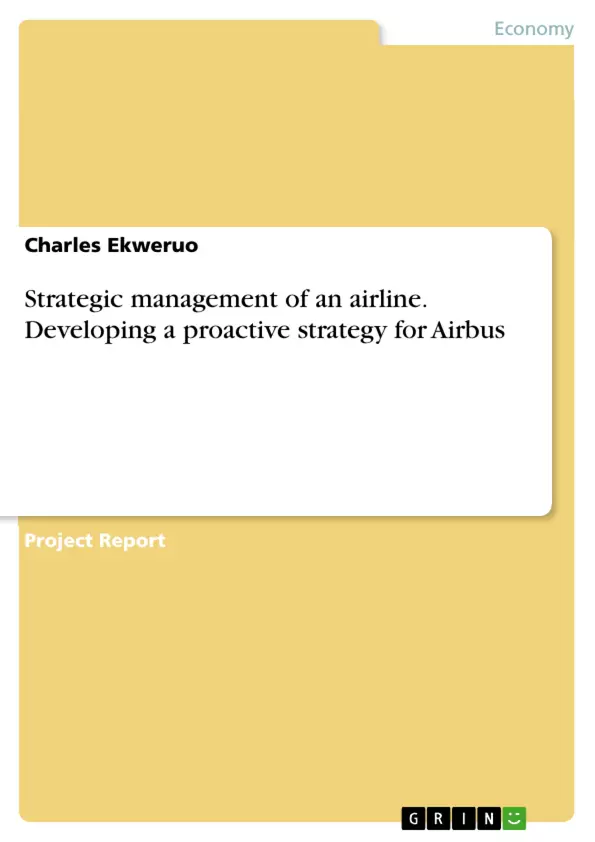This report will give a comprehensive analysis of Airbus based on strategic analysis (internal and external) and strategic formulation and will conclude with a recommendation.
One of the most vital tools for human success is strategy. Even- though influential people for example, Barrack Obama, and Warren Buffet epitomizes luck, what really made them successful was to have a clear goal, understanding of their competitive environment and most importantly, identifying opportunity when they appeared and to have the clarity of direction and the tractability necessary to exploit these chances- effective implementation. Reason is that without a consistency of direction, based on understanding their environment and a keen awareness of how to maneuver into a position of advantage, competitors will out-compete them.
Therefore, strategy refers to having a succinct and articulate goal, and plans to achieving it - put succinctly, a good strategy is about winning.
In light of constant change and relentless competition ,strategy becomes less about building positions of sustained competitive advantage rather, more about developing the responsiveness and flexibility to create successive temporary advantages-the economic downturn in 2008-9, is encouraging new thinking about the purpose of business. Disillusion with “shareholder value capitalism” has been accompanied by renewed interest in corporate social responsibility, ethics, and sustainability of the natural environment and the role of social legitimacy in long-term corporate success.
Inhaltsverzeichnis (Table of Contents)
- Executive summary
- 1. INTRODUCTION
- Part 2- Strategic analysis:
- 2.1. Prescriptive Purpose delivered through: Mission, Objectives and Ethics.
- 2.2. Internal analysis..
- 2.2a. Internal resources:.
- 2.2b. Knowledge, Technology and Innovation...
- 2.3 External Analysis ...
- 2.3a. Macro environment -PESTLE.
- 2.3b.Micro Environment -PORTER'S FIVE FORCES..
- 2.4. Strategy Dynamics……………………..
- PART 3. STRATEGY FORMULATION.
- 3.1. Developing Strategic Option: ......
- Part.4. Strategy Evaluation from an Emergent Viewpoint...........
- Part.5. Conclusion and Recommendation
Zielsetzung und Themenschwerpunkte (Objectives and Key Themes)
This report provides a comprehensive analysis of Airbus's organizational strategy, developing a strategic option for the company. It examines Airbus's mission, objectives, and ethics, internal resources, external environment, and strategy dynamics. The report also explores the importance of innovation for Airbus, emphasizing the need to achieve a competitive advantage and realize its vision of green airplanes.
- Strategic analysis of Airbus
- Developing a strategic option for Airbus
- Importance of innovation for Airbus
- External environment analysis using PESTLE and Porter's Five Forces
- Strategy evaluation from an emergent viewpoint
Zusammenfassung der Kapitel (Chapter Summaries)
The Executive Summary provides an overview of the report, highlighting the key findings and recommendations. Chapter 1, "Introduction," emphasizes the importance of strategy in achieving success and discusses the evolving nature of strategic thinking in a rapidly changing environment.
Part 2, "Strategic Analysis," delves into both internal and external factors impacting Airbus's strategic landscape. The internal analysis focuses on Airbus's mission, objectives, and ethics, exploring the company's commitment to innovation and its pursuit of a green aviation future. It also assesses Airbus's internal resources and capabilities, analyzing how these assets contribute to the company's competitive advantage.
The external analysis uses PESTLE and Porter's Five Forces frameworks to evaluate the macro and micro environments influencing Airbus's operations. The chapter explores the impact of political factors, economic factors, and environmental factors on the company's strategic choices. It also analyzes the competitive landscape and the importance of stakeholder engagement for Airbus's long-term viability.
Part 3, "Strategy Formulation," outlines a strategic option for Airbus based on its internal and external analysis. This section utilizes frameworks like SWOT analysis and BCG growth-share matrix to develop recommendations for business and corporate levels.
Part 4, "Strategy Evaluation from an Emergent Viewpoint," assesses the strategic options using a learning-based approach, highlighting the dynamic and evolving nature of strategy. The chapter acknowledges the limitations of the frameworks used while emphasizing their pragmatic value for analyzing Airbus's strategic landscape.
Schlüsselwörter (Keywords)
Key terms and concepts explored in the report include: strategic analysis, strategic option, innovation, competitive advantage, green airplanes, PESTLE analysis, Porter's Five Forces, stakeholder engagement, SWOT analysis, BCG growth-share matrix, emergent viewpoint, learning-based approach, and EFQM Excellence Model.
- Quote paper
- Charles Ekweruo (Author), 2012, Strategic management of an airline. Developing a proactive strategy for Airbus, Munich, GRIN Verlag, https://www.grin.com/document/187839



